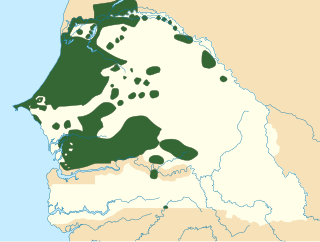Related Research Articles

French Guinea was a French colonial possession in West Africa. Its borders, while changed over time, were in 1958 those of the current independent nation of Guinea.

Senegal, officially the Republic of Senegal,{{efn|(French: République du Sénégal; Wolof: Réewum Senegaal; Pulaar : 𞤈𞤫𞤲𞤣𞤢𞥄𞤲𞤣𞤭 𞤅𞤫𞤲𞤫𞤺𞤢𞥄𞤤𞤭 ; Arabic: جمهورية السنغال, romanized: Jumhūriyya al-Sinigāl is a country in West Africa, on the Atlantic Ocean coastline. Senegal is bordered by Mauritania to the north, Mali to the east, Guinea to the southeast and Guinea-Bissau to the southwest. Senegal nearly surrounds The Gambia, a country occupying a narrow sliver of land along the banks of the Gambia River, which separates Senegal's southern region of Casamance from the rest of the country. Senegal also shares a maritime border with Cape Verde. Senegal's economic and political capital is Dakar.

Dakar is the capital and largest city of Senegal. The department of Dakar has a population of 1,182,417, whereas the population of the Dakar metropolitan area is estimated at 3.9 million in 2023.

Bissau is the capital and largest city of Guinea-Bissau. As of 2015, it had a population of 492,004. Bissau is located on the Geba River estuary, off the Atlantic Ocean, and is Guinea-Bissau's largest city, major port, its administrative and military center.

Wolof is a Niger–Congo language spoken by the Wolof people in much of West African subregion of Senegambia that is split between the countries of Senegal, Mauritania, and the Gambia. Like the neighbouring languages Serer and Fula, it belongs to the Senegambian branch of the Niger–Congo language family. Unlike most other languages of its family, Wolof is not a tonal language.

The West Atlantic languages of West Africa are a major subgroup of the Niger–Congo languages.

Djibril Tamsir Niane was a Guinean historian, playwright, and short story writer.
The Mankanya language is spoken by approximately 86,000 people in Guinea-Bissau, Senegal and Gambia primarily belonging to the ethnic group of the same name. It belongs to the Bak branch of the Atlantic–Congo language family.

The Central Bank of West African States is a central bank serving the eight west African countries which share the common West African CFA franc currency and comprise the West African Economic and Monetary Union.

Guinea-Bissau–United States relations are bilateral relations between Guinea-Bissau and the United States.
IFAN is a cultural and scientific institute in the nations of the former French West Africa. Founded in Dakar, Senegal in 1938 as the Institut français d’Afrique noire, the name was changed only in 1966. It was headquartered in what is now the building of the IFAN Museum of African Arts. Since its founding, its charge was to study the language, history, and culture of the peoples ruled by French colonialism in Africa.

There are various ethnic groups in Senegal, The Wolof according to CIA statistics are the majority ethnic group in Senegal. Many subgroups of those can be further distinguished, based on religion, location and language. According to one 2005 estimate, there are at least twenty distinguishable groups of largely varying size.
The Bak languages are a group of typologically Atlantic languages of Senegal and Guinea-Bissau linked in 2010 to the erstwhile Atlantic isolate Bijago. Bak languages are non-tonal.
Safene (Saafen), Safi or Saafi-Saafi, is the principal Cangin language, spoken by 200,000 people in Senegal. Speakers are heavily concentrated in the area surrounding Dakar, particularly in the Thies Region.
Manjak or Manjack or Njak is a Bak language of Guinea-Bissau and Senegal. The language is also known as Kanyop.
Papel, or Oium (Moium), is a Bak language of Guinea-Bissau.

Ziguinchor is the capital of the Ziguinchor Region, and the chief town of the Casamance area of Senegal, lying at the mouth of the Casamance River. It has a population of over 230,000. It is the seventh largest city of Senegal, but largely separated from the north of the country by The Gambia.

The African Judo Union (AJU) is the governing body of judo in Africa. It is one of the five continental confederations making up the International Judo Federation (IJF). AJU was formed on 28 November 1961 in Dakar (Senegal). AJU has headquarters in Madagascar and consists of 54 member federations.
References
- ↑ Wilson, William André Auquier. 2007. Guinea Languages of the Atlantic group: description and internal classification. (Schriften zur Afrikanistik, 12.) Frankfurt am Main: Peter Lang.
- ↑ Doneux, Jean Léonce. 1975. Lexique manjaku. (Les Langues Africaines au Sénégal, 63.) Dakar: Centre de Linguistique Appliquée de Dakar.